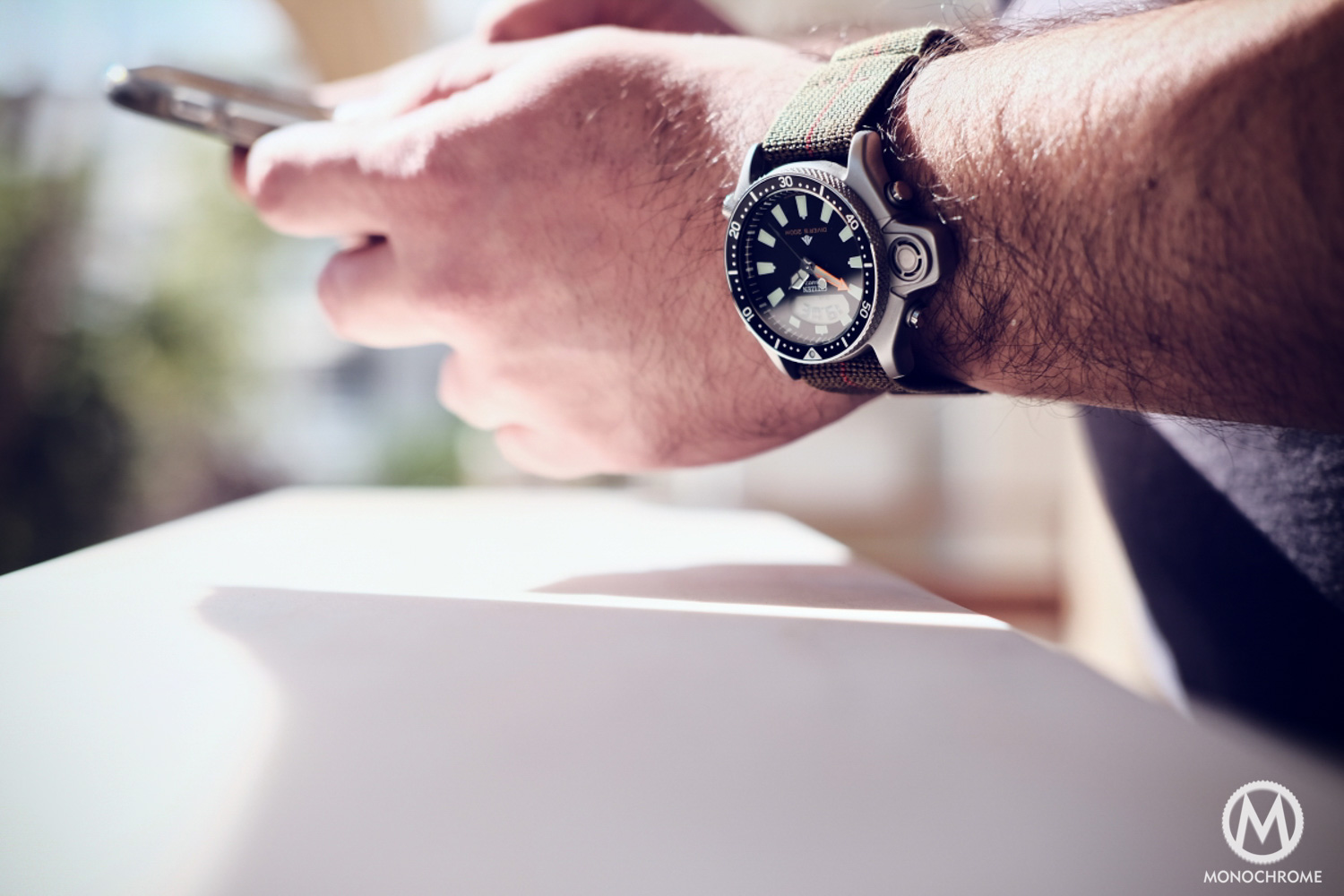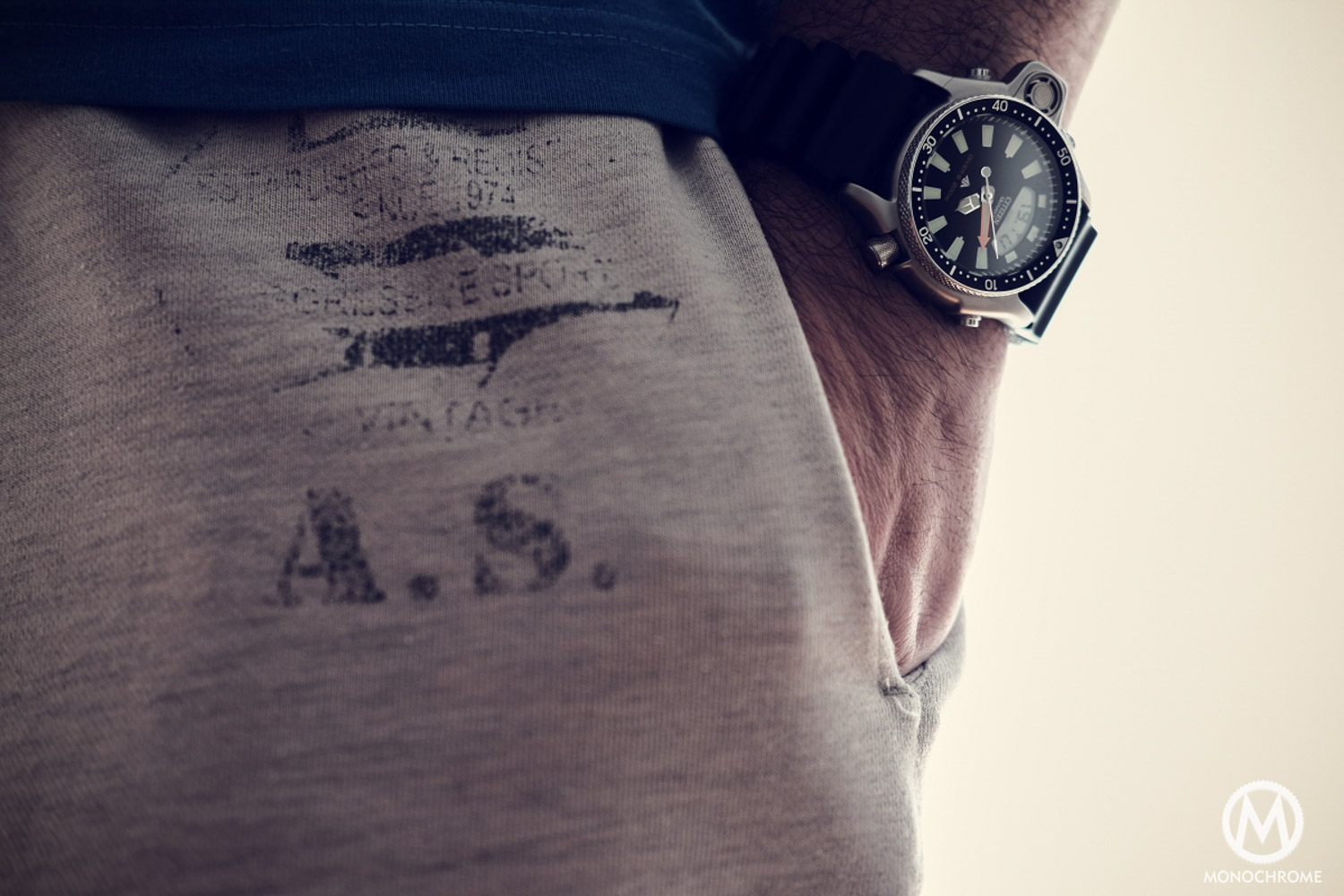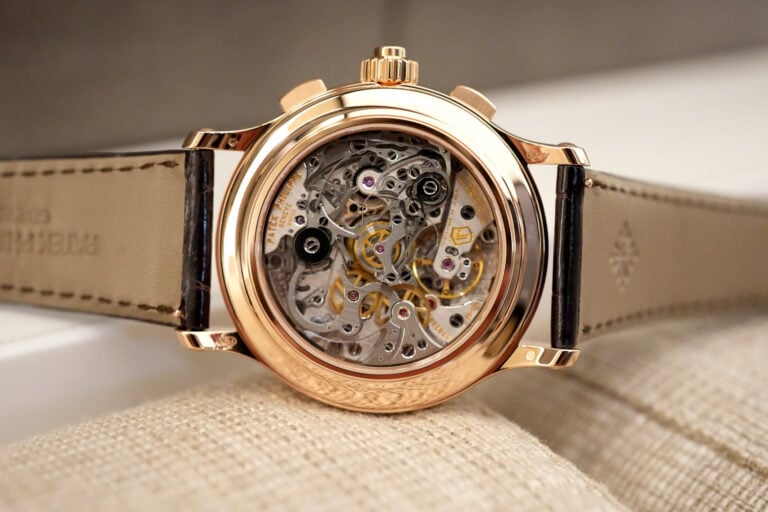Review – Citizen Aqualand Promaster, The Blue Collar Dive Watch from Japan

When we refer to Japan and its watch industry everyone, and rightly so, instantly think of one company: Seiko. However, there is more than that. Although Seiko has produced a large number of excellent, iconic and historical timepieces, it is unfair to forget other companies like Citizen. In this article we are going to examine one of the most iconic dive watches coming from Japan of all time. No, it is not the Tuna Marinemaster or the Seiko 6105, but the iconic Citizen Aqualand Promaster.
Background – Citizen’s History
The Citizen Watch Company was established in 1918, as the Shokosha Watch Research Institute and, in 1924, it produced a pocket watch which Mr. Shinpei Goto, the Mayor of Tokyo, named the “CITIZEN”. After this, the name stuck and was adopted by the company in 1930. From that point onward, Citizen Watch Co. have been producing extremely fine and innovative watches. For example, in 1959, the company created the first Japanese water-resistant watch, the “Parawater”, while in 1962 they developed the world’s thinnest 3 hand watch. In 1970, they introduced one of the world’s first Titanium cased watches the “X-8 Chronometer”, while in 1972 they presented the 60’s “Sports Master”, which we all know as the Bullhead. This model showcased Calibre 8110, which included a zero-position reset mechanism fitted with a shock absorber.
One of Citizen’s first pocket watches that went on sale in 1924
In 1973, the company launched its first quartz wristwatch, while two years later, in 1975, the launch of the now legendary Crystron Mega Quartz left the watch world with little, if any, doubt about where Citizen were heading as a brand. Fitted with caliber 8650, generating a frequency of 4,194,304Hz, it is still to date one of the world’s most accurate wristwatches ever offered for public sale. By the end of the decade, Citizen was producing excellent watches that many times, I would dare to say, were more technically interesting than the offerings of its rivals. For example, towards the end of 1981, Citizen released its 1300m Professional Diver’s watch. At that time, it was the world’s most water-resistant watch available for public use. A few years later, in 1985, Citizen introduced the world’s first watch fitted with an electronic/digital depth gauge, the “Sport Depth Meter”. However, before we proceed with our analysis of the Aqualand we must make a necessary detour.
The concept of Depth Gauge on dive watches
While diving, there are three vital parameters: the diving duration, the diving depth and the orientation of the diver. In the early years of scuba diving, a diver would strap his dive watch on one arm and a bulky depth gauge, accompanied by a compass on the other. Accordingly, he would compare the watch and his depth gauge as he calculated his no-decompression time while submerged. Favre-Leuba, Nivada and Aquadive tried to abolish the usage of an independent depth gauge by developing dive watches that incorporated the depth gauge into the watch. However, these models were extremely complicated and their mechanical nature, or its electromechanical nature in the case of the legendary Aquadive Time-Depth 50, meant they were too complex and needed more maintenance than the usual mechanical dive watch. Furthermore, readings were not that accurate, so divers in some cases stopped using them or used them in redundancy with a dedicated (and known reliable) depth gauge. Therefore, the all mechanical dive / depth gauge watch pretty much eclipsed from systematic usage despite the fact that IWC, Blancpain, Jaeger-LeCoultre and Oris still produce some models, which I do consider marvels of mechanical engineering. However, these are more technological exercises rather than watches that can actually be used in the real world. And here comes the Citizen Aqualand.
The Citizen Aqualand Promaster
In 1986, Citizen released the first dive watch with electronic depth gauge, the Aqualand (ref. C0023). The United States Patent 4611923 was filled on November 27, 1985 and called for an electronic timepiece with a depth gauge, a timepiece circuit, a display unit and a water-pressure sensor. The depth gauge circuit received a signal from the water pressure sensor and generated a depth information. The mode control circuit had the purpose to switch between a timepiece mode and a depth gauge mode, and the display would selectively show the time information signal from the timepiece circuit or the water depth information signal from the depth gauge circuit.
Known for its characteristically bulbous depth sensor on the left side of the case, the Citizen Aqualand pretty much revolutionized dive watches since for the first time, a watch offered a highly dependable but rather inexpensive depth gauge. This ana-digi watch went beyond simply telling current and maximum depth; its digital display also showed dive time, ascent rate and had depth and ascent alarms. The watch also featured a digital stopwatch, and an alarm. The first Aqualand went on to make a huge impact in the sport-diving watch market, with its innovative design and advanced technology and it initiated a whole family of watches from that point onward. Citizen has produced similar variations (AL-0000, JP-1010 for example) ever since in its Promaster line, with all models acquiring a cult status among the diving community.
The first (ref. C0023) Citizen Aqualand was offered in three variants. Stainless steel, Stainless steel with gold ascents (Don’t forget we are in the middle of the 1980’s…) and the highly desirable black PVD version with gold ascents, which was immortalized forever on camera as it was the watch that free diver Enzo Molinari, played by Jean Reno, wore in the famous film Le Grand Bleu by Luc Besson (see below). All first generation Aqualands had a 4-screw casebacks and were running on three batteries. Their ability to indicate depth and other parameters, while at the same time being bullet proof and relatively inexpensive, made them extremely popular. Here in Greece (my homeland) – and from friends in Italy and France – I know personally that the Aqualand was THE diver watch to have in the late 1980’s. Every diver, spear fisherman, and even captains of sailing boats owned one or later variants. The interesting thing is that everyone referred to it as a highly dependable piece of kit, which was vital for daily activities near or under the sea.
Enzo Molinari, interpreted by Jean Reno, in famous film Le Grand Bleu by Luc Besson
In 1992, Citizen introduced the JP2000, which is still in production nowadays. Everything was kept identical except the calendar, which was upgraded – in order to cover up to year 2099 – while the caseback changed to a screw back one. One battery would now be used instead of three and the conservation of energy would be much more linear. The quartz calibre now was the C520/6 (-6 for depth indication in feet). The Aqualand can give its user an indication of depth with a 3% deviation of its indicated value. The depth-measurement display counts from 1m up to 80m, while the diving time measurement can reach the 400-minute mark. The calibre can hold a dive log for up to 4 dives, while there is a depth alarm, diving alarm monitor, ascending speed warning and a low battery warning. We have Analog display time and in parallel, digital display time as well as a calendar. Last but not least, a chronograph function and a regular alarm are there as well.
The Citizen Aqualand is a hefty watch. Its height is 14.5mm, its lug size is 24mm while if you ad the protrusion of the sensor its diameter is 51mm – the case width from 2 to 8 is 46mm (not including the buttons). Despite the numbers, the watch wears pretty well because of its flat profile and because of the 24mm lug size, which balances the watch nicely on top of the wrist. The OEM strap is thick but the “wave” portion makes it flexible enough to wear and we can find a non-decompression limits table printed on one side. The metal buttons are big and easy to operate. One interesting thing is that the manual warns about using the buttons under water, except for the top right hand corner one (for the dive mode). The side of the bezel and crown are knurled to make it easy to grip and turn. The crystal is mineral with no AR coating. Bezel has 60 clicks with firm action. The time is easy to read with a relatively clean dial with big hour markers and very differently shaped hour and minute hands while the digital portion is big enough to be read easily without over powering the dial. A nice detail is the fluorescent orange minute hand.
Conclusion about the Citizen Aqualand
Overall, I would have to say that the Citizen Aqualand is undoubtedly an iconic dive watch. Its competition is way behind in terms of features and functionalities. Its design, with the characteristically bulbous depth sensor, screams dive watch from afar. Its extremely innovative design, its features and its reliability have elevated the Citizen Aqualand to a status of a modern classic. Yes it is quartz, but because of this, it can do all these very useful things for its user. It is one of these rare occasions that a tool watch is packed with features that actually make sense, especially if you are a diver or a spear fisherman – and even if you don’t, you might find the alarm and chronograph function extremely useful.
For me, the Citizen Aqualand is one of the most important dive watches of all time because, after 31 years, it is still quite modern, relevant and cheap. This watch is still very popular in the Citizen catalogue. The Aqualand is legendary because it is instantly recognizable as a tool for divers and it is built to last. After all, I have seen them almost exclusively on the wrist of people that have close connection with the sea, and in some cases, people that I know and respect. Quite simply the first generation Citizen Aqualand might be the definition of the modern tool watch. A blue-collar dive watch extraordinaire.

















19 responses
Great article 🙂
Wish they would still make a pvd version !
Hi Ilias, thanks for this nice article. Indeed you made me reflect on the fact that despite my passion for divers, I still don’t own an Aqualand (however I’ve got other mech promasters).
Agree on the fact that in Japan there are many brands that are not much considered due to the high exposure of Seiko. Talking about divers, I’d mention the Orient 300m which in my opinion is one of the best “real” divers ever.
Regards,
slide68
@ G. Yes, i wish that too.
@ Andrea, You are quite right! The Orient 300m is also one of the great japanese divers.
Thank you Ilias for this article on the Citizen Aqualand Promaster….I have this watch & it has been inseparable with me for over 24 years. I have dived in parts all over the world & every time I glance at my watch…so many fond underwater dive memories keep flooding back. I was very pleased when I could still purchase a brand new identical watch recently, as I had to retire the old one only due to external appearance wear & tear…Many modern day watches available but, I chose to replace with my favourite…Dave B.
ORIGINAL version had a 6-screw casebacks – not 4-screw as you state…..
Nice article! I love this watch. Mine was bought in 2003. Still perfect. Is amazing the robustness of this watch. No scratches or marks. Also the glass is still perfect! I have one question: I’m looking for a different straps then the rubber one. In the first photo I can see one that will be perfect! (white sewings) Do you have the model type? Thx!
I am the original owner of a vintage model,caliberC023,the batteries are gone.The company in a bad business move no longer offers parts or service. Any one on the forum got any helpful hints or know of a good service tech that works on them. Thanks guys.
Aqualand was the first watch I bought coming from my salary.Though it has some scratches and had several battery and rubber strap replacements, it has been my favorite watch.for the past 22 years (August 1996 to present). Still alive and ticking. I was planning to buy a new one, unfortunately it is no longer sold in our country. You can find one but it’s a second hand.
Which strap is featured in the picture with the Robert D Ballard publication in the background?
Hi I have 2 of them fantastic watch bought my first one in 1994, 6 screws on back. Over 100 dives and spear fishing. I’m in South Africa fantastic watch for night dive lot of memory. My local watch shop told me that there is no more spares gaskets available. I am waiting for a answer from Citizen. I also have 2 eco drives diver watches. One with depth sensor. Fabulous watches like Citizen over Seiko. Thanks!
Hi Ilias. I would also like to know which strap is featured in the picture with the Robert D Ballard publication in the background? Look forward to your response thank you.
Thank you for the in depth story.
I bought this watch from one of my trips to Greece in a small store in Athens near Omoni in the mid 2000 . This was my second Citizen dive watch. Currently I have 5 different Citizen sets in my collection. I would also recommend for frequent divers to change the band and install a safety dive strap similar to the waterborne or citizen version.
bonjour,j ai une aqualand ancien modele co22-088093 y, mais je ne sais pas de quelle annees elle est,j ai juste la reference :0090757,quel qu un peu m aider?.Merci Luigi
Este clasico incombustible al paso del tiempo, logra sacar de la indiferencia al mas pinto de la paloma. Citizen debia animarse a sacar una reedición con calibre Ecodrive motorizado, cristal de zafiro con capa antireflejos y correa de seguridad de buceo junto a anclaje por tornillos a las garras de la caja. Lógicamente con precio incrementado. Como dicen por mi tierra, “A un gustazo, un trancazo” Yo pagaria sin dudar estas mejoras. Gracias por el artículo de calidad como siempre es costumbre en este sitio.
Really sure that the JP2000 was released in 1992?
Mine is still going strong, purchased new in 1991. Two tone silver/gold.
Found a watch store in the UK that had a few of the 6 screw caseback seals and a Genuine Citizen metal two tone dress band.
The trio of batteries needs to be replaced around every 24 months or so. I wear it every day.
i thought c022 was the 1st version
I thought the CO20 was the first version.
I have the Classic 1 (6 screws on back and CO23) and have been wearing it since I purchased it in as I recall in 1989 or 1990, so 34/35 years now! I purchased it from a dive shop on Whittier Blvd in Whittier California and just TODAY (I have lived in Medellin, Colombia for 10+ years) had a local watch guy in my small pueblo replace all 3 batteries, cost me 80,000 pesos or about $20. USD. The old man watch guy shook his head when he opened the back as he has never seen 3 batteries in any watch ever, hehehe
This watch has traveled the world with me and more recently sailing the Caribbean and diving/snorkeling along with expeditions through the Brazilian Amazon rain forests. This beauty shows up in many of my adventures throughout the decades, one hell of a watch, wearing it right now, a beauty with a story that could fill a thousand page book.